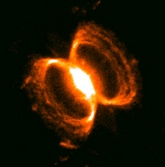Was Chicken Little Right?
Posted by hyperpat on May 19, 2008
The doom-and-gloom crowd has been predicting that we’ll run out of oil real soon now for a long time. I can remember articles in the sixties that predicted this would happen by 1990, more articles in seventies that pushed this out another ten years, and current articles that peg the date at 2040. Obviously, at least so far, this hasn’t happened. And I doubt that the 2040 date will be any more accurate that the prior predictions. But what has happened is that the price of oil has now reached the point that alternative energy generation methods are beginning to become cost competitive. Never mind that the current price is probably artificially inflated by speculators and cartels that are only looking to get theirs while the getting is good, in real terms it has become more expensive to find, drill, extract, and refine oil. There truly is less readily available (read: cheap) oil to be found out there, so the current price is unlikely to decline very much.
As our current high-tech society is very much dependent on this energy source, is it perhaps time to really start worrying? The answer to that depends on what the alternatives are, and how diligently we investigate these alternatives. So far, the considered alternatives are wind, solar, hydro-electric, fuel cell, nuclear fission, nuclear fusion, biomass, and tidal. Let’s look at each of these and see just how far they’ll go towards providing the world with both cheap and reliable power.
Wind power: Lot’s of energy available here. Winds are basically generated by two major factors, the solar influx and the Earth’s spin, neither of which are going away anytime soon. Capturing this energy in significant amounts is another story. There are few places in the world that have steady winds high enough to justify the cost of the high tech windmills that can efficiently turn that wind power into electricity. Currently, wind power provides less than 1% of electricity production in the U.S. If all possible sites for wind power were developed, it could provide perhaps 20% of the electricity demand, but there are two problems with this. First is that these wind farms would then occupy something like 300,000 square miles of land area. As the U.S. has only 3.7 million square miles of land, this represents something like 8% of all the land, most of which is used for other purposes right now. Second is the problem that the energy produced is a) highly variable b) not easily stored, meaning it has to used when it is produced.
Hydro-Electric, currently providing about 11% of the electricity demand, has similar problems, along with the fact that most of the available hydro-power sites are already in use, and to add more would cause significant changes to the ecologies of the areas around them.
Fuel cells are not net energy producers. It takes more energy to produce the hydrogen used than the fuel cell will deliver. They are a partial answer to the problem of storing energy, and at least can be considered partially mobile if placed in cars. If we can generate enough energy via other means, then these items would be a possible replacement for all the oil we gobble up as gasoline. However, the distribution channels for hydrogen are not in place, and building up the infrastructure necessary represents a large investment in both time and money.
Bio-mass generation has similar problems as those of fuel cells, as it takes more energy to grow and process the plant material needed than will be generated by the final product. It has an advantage in that it won’t require a whole new infrastructure to distribute the end product, but once again the total land area required to grow the necessary material is a significant fraction of our total land area, and would force out farmland currently used to grow edible crops – something we are already seeing in the price of basic foodstuffs in the grocery store. However, this type of technology also provides us with a way to make the oils we need for things other than power generation: lubricants, ingredients in plastics, and other such uses. If crude oil really does run out or becomes prohibitively expensive to get, this avenue is available, and additional research and technological improvements need to be actively pursued.
Tidal power is a non-starter with today’s technology. While there’s a lot of energy in the tides, in most places of the world this energy is very diffuse. Only in few bays is there enough of a water height differential to make energy generation efficient or possible.
Nuclear fission power is an option. It is possible for us to generated a much larger fraction of our energy needs this way than we currently do, but once again there are significant costs and risks associated with going down this route, not the least of which is the spent material disposal problem, along with the terrorist/crazy factor. Nuclear fusion, on the other hand, just isn’t possible today. We really haven’t solved the technological issues with this one yet, and probably won’t for some time, even though they’ve been predicting it’s advent as 15 years from the present for the last forty years. If it ever does become a reality that can actually produce more power than what it takes to generate the reaction, it might become the ultimate savior of our high-tech civilization, but I wouldn’t count on it.
Which leaves solar power as a possible solution. Solar comes in couple of different flavors: direct electricity generation, and as a heat source to drive conventional generators. The heating method is fairly simple, and can be of great use in relatively undeveloped nations, but it is not terribly efficient. Direct conversion shows more promise, though current solar cell efficiency is really not high enough to make it cost competitive with other generation methods. But calculations of the potential energy available show that, yes, it can provide enough power, assuming we wish to the cover the state of Arizona with solar panels, along with every housetop in America. There is still the problem of variable generation (no power produced at night!), the same problem that plagues some of the other potential generation methods. Some better means of storing energy must be found – battery technology is right now not anywhere near to being able to handle this.
Or there is one other alternative: put your solar generation plant in space, where the sun shines all the time, where there is plenty of room not needed for other purposes, and microwave the resultant power down to the ground. This is the option I’d like to put my money on and into, but so far at least it doesn’t seem as if there is any real work being done to make this happen, even though it’s within our technological capability. It would just take an astronomical (pun intended) amount to build it. Our average citizen complains about the amount of money being used for space exploration, as they see no direct benefit from it (we’re just throwing dollars into space!). Science fiction stories have been touting the benefits available from space for a long time, but those who read the stuff represent a very tiny fraction of the entire populace, and it’s still “Buck Rogers stuff” for most. Perhaps if they could be shown how it would directly affect their pocketbook via their power bill they might be more willing to spend more to make true space industry an economically feasible reality.
The world’s energy demand is not going down. If we don’t wish to see our way of life collapse into wars over a declining resource, or subside into just making-do, with a lower standard of living for all, real work must be done to find appropriate energy sources, all the while keeping in mind just what is ultimately possible with any particular technology and what its total costs are.



Leave a comment